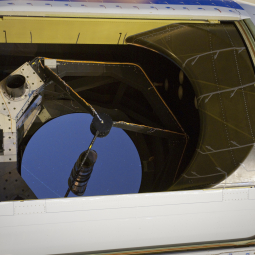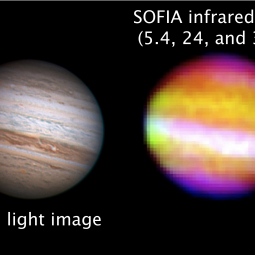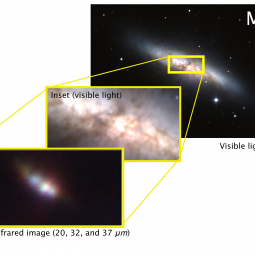During the past year SOFIA, the Stratospheric Observatory For Infrared Astronomy, achieved the program’s goals and passed the program’s milestones at a pace almost as fast as the observatory can fly.
At the end of 2009, SOFIA’s engineering team succeeded in flying the observatory for more than an hour with the telescope cavity door fully open. Having achieved this success, 2010 began with additional in-flight testing of the telescope cavity door and its software system.
Because SOFIA flies with the largest telescope ever installed in an aircraft, each system must be tested under actual conditions, at altitude, with performance recorded and a baseline for safe operations established. Then, the system’s performance must be repeated to validate the earlier tests. Once the telescope cavity door system had been well-studied, SOFIA engineers began a flight program to validate the telescope assembly’s vibration isolation system, its inertial stabilization system, and the pointing control system. These tests were led by the SOFIA program’s German scientific partners from the Deutsches SOFIA Institute (DSI) at the University of Stuttgart, and were completed in the fall.
On Feb. 8, 2010, principal investigator Terry Herter and his team from Cornell University and Ithaca College, both located in Ithaca, N.Y., delivered what would become SOFIA’s first operationally flown instrument, the Faint Object InfraRed Camera for the SOFIA Telescope, or FORCAST. This instrument is a mid-infrared camera that records images in the five to 40 micron range (five to eight microns, 17-25 microns, and 25-40 microns – depending upon which channels or filters are selected. For comparison, the human eye sees radiation with wavelengths of 0.4 to 0.7 microns.) The instrument was delivered to SOFIA’s base of operations at the NASA Dryden Aircraft Operations Facility (DAOF) in Palmdale, Calif., and was quickly set-up in one of the facility’s laboratories. In the lab, engineers from the FORCAST team ran the instrument through its paces to verify performance before installing it on the SOFIA telescope.
Achieving “First Light”
Once the FORCAST instrument checked out in the lab, the instrument was mounted on SOFIA’s telescope and a series of ground-based rehearsals on the tarmac, known as “Line Ops,” began at sundown on May 19. From the ground, SOFIA tracked the planet Mars and spent a number of hours capturing images of Polaris, the North Star, to check the telescope’s alignment and focus. By May 22, testing was complete and SOFIA’s science staff took the weekend off to rest.
“First Light” is a ceremonial milestone in the astronomical community when photons from a celestial object officially travel down a telescope’s tube for the first time. For SOFIA, first light was determined to be the first time a celestial object was imaged at altitude – a little different than a ground-based telescope, but an event certainly worthy of celebration. Around 10 p.m., on May 25, the SOFIA crew boarded the aircraft and departed Palmdale for the flying observatory’s first light flight. Departing to the west, SOFIA flew south to an area of restricted airspace off the coast of San Diego to seek its first light targets. While cruising to its flight area, the telescope door was opened to cool the mirrors to an ideal temperature between -30 and -40 degrees Celsius (-22 to -40 degrees Fahrenheit). In the late evening hours of May 25, infrared light that had been emitted from the red supergiant star Antares (Alpha Scorpii) 550 years ago traveled through SOFIA’s telescope and was recorded on the FORCAST instrument.
The observatory’s second target for the evening was the planet Jupiter, which was imaged at wavelengths of 5.4, 24, and 37 microns (24 microns is very hard to see from ground-based telescopes while 5.4 and 37 microns are impossible to see from Earth). The FORCAST instrument looked through the clouds of Jupiter to record heat radiating from the interior of the planet.
Observations of Jupiter were followed by a close look at the galaxy Messier 82 in the constellation Ursa Major. Peering through obscuring clouds of dust and gas in the galaxy, SOFIA captured images of the star-forming heart of the galaxy more than 10 million light years away. The first light flight was not only the first time photons went down the telescope, but was planned as a demonstration of SOFIA’s stability and versatility, imaging stars, planets and a galaxy on the same flight.
Subsequent to the first light flight, the FORCAST instrument was flown on two additional 10-hour flights where the observatory team spent time looking at a number of stars used as calibration tests of both the telescope and the instrument.
“Looking back on this accomplishment, I could not be prouder of our team in their commitment to the project, their dedication to completing the required flight tests, and meeting the first light milestone on schedule,” said NASA SOFIA Program Manager Bob Meyer. “These tasks had to be finished before SOFIA could move from the testing phase to that of a flying observatory, which is about to release world-class astronomical science results.”
Observatory in Operation: Flights, Calls for Proposals, New Instruments
After the first light flight, SOFIA entered its “Short Science” observing phase that highlights the capabilities of the airborne observatory. The Short Science program consists of three flights with FORCAST (accomplished at the end of 2010) and three observing flights in spring 2011 with the German REceiver for Astronomy at Terahertz Frequencies, or GREAT, a spectrometer developed by a team from the Max Planck Institute for Radioastronomy, Bonn, Germany, led by principal investigator Rolf Güsten. (GREAT will make its initial flight on SOFIA in April 2011.) GREAT produces very high-resolution spectra between 60 and 200 microns and has been designed with a beam splitter that enables two channels to be monitored at a time.
“For scientists, GREAT will provide a new opportunity to study the atmospheres of planets, examine the chemical composition of the interstellar medium, and expand our knowledge of circumstellar disks around young stars,” said Deputy SOFIA Science Mission Operations Director Hans Zinnecker, who is detailed to the SOFIA program from the University of Stuttgart, Germany. “The international collaboration of GREAT and SOFIA delivers one of the most versatile and unique astronomical instruments available for studying the far infrared spectrum. For the foreseeable future, GREAT is the only instrument, ground- or space-based, that is able to collect such data.”
The follow-on to Short Science will be “Basic Science,” an observing period open to all astronomers by peer-reviewed proposal. The call for Basic Science proposals was released in April 2010 and multiple proposals were received from 26 U.S. institutions in 12 states and five international institutions from four countries. Proposals were awarded observing time through a peer-review process organized by the Universities Space Research Association (USRA). Researchers awarded time will participate in the Basic Science observation phase in mid-2011. Details of the basic science program can be found here.
“We were gratified to receive requests for more than three and one-half times the available amount of observing time,” said USRA/SOFIA Science Mission Operations Director Erick Young. “The over-subscription demonstrates a significant amount of interest in using SOFIA within the scientific community.” The next call for observing proposals will occur in late 2011.
In June, SOFIA science staff and interested researchers gathered at the Asilomar Conference Center to discuss the next generation of instruments for SOFIA. Valuable input was received and incorporated into the parameters of NASA’s announcement of opportunity for second-generation instruments. Final solicitation for new instruments will take place in mid-2011.
First Science Flights
SOFIA made its initial science flight on Nov. 30, 2010. FORCAST principal investigator Terry Herter was on board leading the collection of data. In addition to the FORCAST team, Herter was joined by Mark Morris (University of California, Los Angeles) and Paul Harvey (University of Colorado, Boulder). Morris and Harvey made proposals and were selected to participate with the FORCAST team for the Short Science flights. Celestial targets imaged during the initial science flights included Comet Hartley, star-forming nebulae Messier 42, W3 IRS5, and Sharpless 140.
“SOFIA and its instruments will enable us to see regions of the galaxy at infrared wavelengths that, at this time, can not be done from any other current telescope, either ground- or space-based,” said NASA SOFIA Project Scientist Pamela Marcum. Marcum was onboard SOFIA monitoring operations on the second of the science flights. “We anticipate a number of very interesting scientific papers to result from observations made during SOFIA’s first science flights. Our team was looking at structures in the clouds of star-forming regions as well as the heat radiating from dozens of newborn stars in the Orion constellation. There is a lot of interest in learning more about how these stars develop, and SOFIA is an excellent tool for expanding our knowledge.”
Looking ahead
In 2011, researchers anticipate releasing scientific results from SOFIA’s flights. NASA is planning on issuing the final solicitation for new instruments around mid-year. Scientists will have the opportunity to apply for time on SOFIA in late 2011.
During 2011, the SOFIA team will start its Airborne Astronomy Ambassadors program where educators will have the opportunity to participate in science operations with SOFIA researchers. Educators will then take their experiences back to the public by presenting workshops, training other teachers, and presenting programs at schools, science centers and to groups within the local community. Additional information for educators can be found here.
NASA’s Bob Meyer summed up the excitement SOFIA has brought to the astronomical community by saying, “Everyone on the SOFIA team has high expectations for this new phase of operations and we anticipate more valuable and intriguing scientific results will come from our next set of observations.”
SOFIA is a joint program between NASA and the German Aerospace Agency (Deutsches Zentrum für Luft- und Raumfahrt – DLR), Germany. The SOFIA program is managed at NASA's Dryden Aircraft Operations Facility, Palmdale, Calif. NASA's Ames Research Center, Moffett Field, Calif., manages the SOFIA science and mission operations in cooperation with the Universities Space Research Association (USRA), Columbia, Md., and the Deutsches SOFIA Institute (DSI), Stuttgart, Germany.




